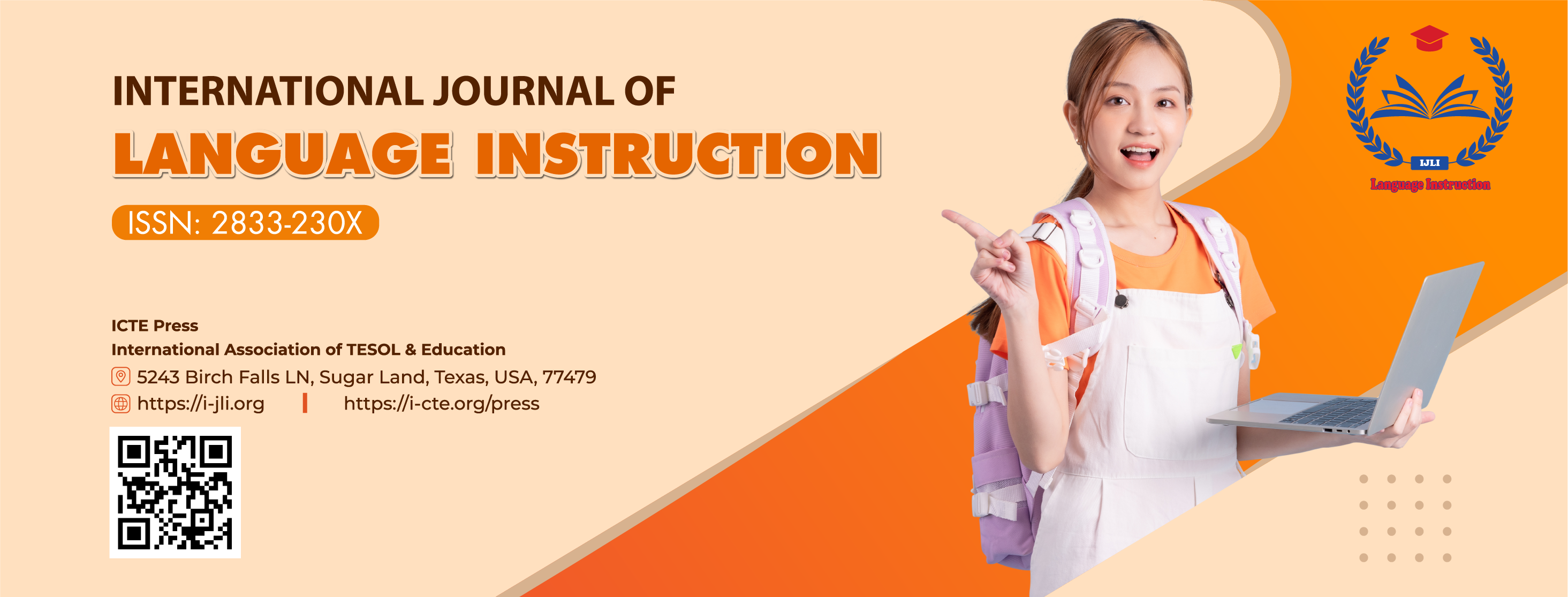Benefits of Teaching English to Children in Virtual Classes: Teachers’ Perspectives from Khanh Hoa Province, Viet Nam
DOI:
https://doi.org/10.54855/ijli.24316Keywords:
teaching English, children, virtual classrooms, teachers’ perspectives, benefitsAbstract
Over the past decade, technological advancements have greatly impacted the education industry, leading to the rise of online teaching and learning as a promising trend worldwide. However, in Viet Nam, research on virtual classrooms for young learners has been relatively limited. As a result, a recent study sought to examine English teachers’ perspectives on the benefits of teaching English to children virtually. This study utilized a mixed-methods approach to collect data through an online questionnaire distributed to 52 English teachers in Khanh Hoa Province, Central Viet Nam, who had at least one-year experience in teaching English to children online and in-depth interviews with 15 of them. The findings revealed that virtual classrooms offer numerous benefits for teachers, such as integrating all four language skills, enhancing teaching and learning performance, improving their digital skills, keeping up with educational technology trends, accessing a wealth of resources on educational websites, and fostering creativity in developing activities that enhance children’s engagement and motivation in English lessons. Overall, this study highlights the valuable benefits of teaching the English language to children in virtual settings. The findings hold relevance for other stakeholders involved in the development of virtual language education in Viet Nam and similar contexts.References
Alhat, S. (2020). Virtual Classroom: A Future of Education Post-COVID-19. Shanlax International Journal of Education, 8(4), 101-104. https://doi.org/10.34293/education.v8i4.3238
Arden, M. (2021, July 9). Using Virtual Classrooms to Positively Impact the Future of Learning. Retrieved from: https://www.prodigygame.com/main-en/blog/virtual-classroom/
Bazo, P., & Cabrera, M. P. (2002). Teaching the Four Skills in the Primary EFL Classroom. The Internet TESL Journal. Retrieved from: http://iteslj.org/Techniques/Bazo-FourSkills.html
Boettcher, J. V., & Conrad, R. M. (2010). The online teaching survival guide: Simple and practical pedagogical tips. John Wiley & Sons.
Cao, L. T. (2023). Benefits and challenges of using LMS in blended learning: Views from EFL teachers and students at a Vietnamese public university. The International Journal of TESOL & Education, 3(3), 78-100. https://doi.org/10.54855/ijte.23335
Cheng, W., & Warren, M. (1997). Having second thoughts: Student perceptions before and after a peer assessment exercise. Studies in Higher Education, 22(2), 233-239. https://doi.org/10.1080/03075079712331381064
Christopoulos, A., Conrad, M., & Shukla, M. (2018). Increasing student engagement through virtual interactions: How?. Virtual Reality, 22, 353-369. https://doi.org/10.1007/s10055-017-0330-3
David, J., & Liss, R. (2006). Effective academic writing 3 (1st ed.). USA: Oxford University Press.
Dawley, L. (2007). The Tools for Successful Online Teaching. Information Science Publishing.
Dash, B. B. (2022). Digital Tools for Teaching and Learning English Language in 21st Century. International Journal of English and Studies (IJOES), 4(2), 8-13. http://dx.doi.org/10.47311/IJOES.2022.4202
Dau, L. T. (2022). Remote Teaching amid the Covid-19 Pandemic in Viet Nam: Primary School EFL Teachers’ Practices and Perceptions. AsiaCALL Online Journal, 13(1), 1-21. Retrieved from https://asiacall.info/acoj/index.php/journal/article/view/101
Dudeney, G., & Hockly, N. (2007). How to Teach English with Technology. England: Pearson Education Limited.
Elfeky, A. I., & Elbyaly, M. Y. (2023). The impact of virtual classrooms on the development of digital application skills among teachers of digital skills in Najran region. Annals of forest research, 66(1), 2044-2056. Retrieve from: https://www.e-afr.org/article/view-2023/pdf/2044.pdf
Fran. (2022). Online learning in a post-pandemic world: The Future of Learning Report 2022. Retrieved from: https://www.futurelearn.com/info/insights/online-learning-post-pandemic
Garton , S., & Copland, F. (2019). The Routledge Handbook of Teaching English to Young Learners. Routledge.
Gedera, D. P. (2014). Students’ experiences of learning in a virtual classroom. IJEDICT, 10(4), 93-101. http://ijedict.dec.uwi.edu/viewarticle.php?id=1845
Hamouda, A. (2020). The Effect of Virtual classes on Saudi EFL Students’ Speaking Skills. International Journal of Linguistics, Literature and Translation (IJLLT), 3(4), 175-204. DOI: https://doi.org/10.32996/ijllt.2020.3.4.18
Jamilah , J., & Fahyuni, E. F. (2022). The Future of Online Learning in the Post-COVID-19 Era. KnE Social Sciences, 7(10), 497-505. DOI: https://doi.org/10.18502/kss.v7i10.11251
Joan, R. (2018). Virtual classroom: a gift for disabled children. Journal on School Educational Technology, 14(2), 7-11. Retrieve from: https://eric.ed.gov/?id=EJ1208720
Joint Information Systems Committee (JISC). (2010). Effective Assessment in a Digital Age: A Guide to Technology-enhanced Assessment and Feedback. Bristol, UK: HEFCE.
Harmer, J. (2007). How to teach English. England: Pearson Education Limited.
Harmer, J. (2015). The Practice of English Language Teaching. Fifth edition. Longman.
Hummel, K. M. (2014). Introducing second language acquisition: Perspectives and practices. John Wiley & Son.
Hossain, M. (2021). English Language Teaching through Virtual Classroom during COVID-19 Lockdown in Bangladesh: Challenges and Propositions. Journal of English Education and Teaching (JEET), 5(1), 41-60. https://doi.org/10.33369/jeet.5.1.41-60
Karsenti, T., Kozarenko, O. M., & Skakunova, V. A. (2020). Digital Technologies in Teaching and Learning Foreign Languages: Pedagogical Strategies and Teachers’ Professional Competence. Education and Self Development, 15(3), 76-88. https://doi.org/10.26907/esd15.3.07
Ko, S., & Rossen, S. (2017). Teaching online: A practical guide. Routledge.
Khoshsima, H., & Sayadi, F. (2016). The Effect of Virtual Language Learning Method on Writing Ability of Iranian Intermediate EFL Learners. Advances in Language and Literary Studies, 7(2), 192-202. http://dx.doi.org/10.7575/aiac.alls.v.7n.2p.192
Le, T. T., & Pham, T. T. (2023). Embracing the Digital Shift: The Future of Virtual Learning in Post-Pandemic Viet Nam. Am J Biomed Sci & Res, 19(2), 188-189. AJBSR.MS.ID.002567, DOI: https://doi.org/10.34297/AJBSR.2023.19.002567
Le, T. T., Truong, L. B., & Pham, H. A. (2022). An investigation into Quang Tri primary school English language teacher’s perspective of ICT integration during the COVID-19 pandemic. European Journal of Foreign Language Teaching, 6(4), 85-98. http://dx.doi.org/10.46827/ejfl.v6i4.4575
Lo, N. P. (2023). Digital learning and the ESL online classroom in higher education: teachers’ perspectives. Asian-Pacific Journal of Secondand Foreign Language Education. 8(1), 24. https://doi.org/10.1186/s40862-023-00198-1
Luu, Q. N. (2021). Teachers’ Perceptions of the Transition from Onsite to Online Teaching during the Covid-19 Pandemic. Journal of Education and e-Learning Research, 8(4), 416-422. DOI: https://doi.org/10.20448/journal.509.2021.84.416.422
Martin , F., & Parker, M. A. (2014). Use of Synchronous Virtual Classrooms: Why, Who, and How? MERLOT Journal of Online Learning and Teaching. Retrieved from: https://www.researchgate.net/publication/265335172_Use_of_Synchronous_Virtual_Classrooms_Why_Who_and_How_MERLOT_Journal_of_Online_Learning_and_Teaching_10_2_192-210
Meena, R. (2019). Benefits and Challenges of Virtual Classroom Teaching System. Journal of Advances and Scholarly Researches in Allied Education, 16(4), 2154-2159. https://ignited.in/I/a/304912
Minea-Pic, A. (2020). Innovating teachers’ professional learning through digital technologies. Organisation for Economic Co-operation and Development (OECD). Retrieved from: https://one.oecd.org/document/EDU/WKP(2020)25/En/pdf
Nedeva, V., & Dimova, E. (2010). Some advantages of E-learning in English language training. Trakia Journal of Sciences, 8(3), 21-28. http://www.uni-sz.bg
Omboto, C. M., & Kanga , A. W. (2022). Where Are We In Space: Examining Teachers’ ICT Competency In Teaching Learners In Special Schools In Kenya. European Journal of Special Education Research, 8(3), 79-91. Retrived from: https://oapub.org/edu/index.php/ejse/article/view/4361/6996
Paudel, P. (2021). Online education: Benefits, challenges and strategies during and after COVID-19 in higher education. International Journal on Studies in Education (IJonSE), 3(2), 70-85. https://doi.org/10.46328/ijonse.32
Pham, H. T. (2018). Applying Blended Learning Method in Teaching English at the University of Da Nang, Viet Nam. The Educational Review, USA, 3(1), 16-21. https://doi.org/10.26855/er.2019.01.002
Pham, T. T. H. (2020). An Investigation Into The Influences Of Online Learning Environments On English Foreign Language Students’ Autonomy At The University Of Da Nang, Viet Nam. 2nd Kuala Lumpur International Conference On Education, Economics And Technology (KLICEET 2020), 26-33. Retrieve from: http://irep.iium.edu.my/87065/2/KLICEET2020%20Conference%20Proceeding.pdf.
Pham, V. P. H., Luong, T. K. P., Tran, T. T. O., & Nguyen, Q. G. (2020). Should Peer E-Comments Replace Traditional Peer Comments? International Journal of Instruction, 13(1), 295-314. https://doi.org/10.29333/iji.2020.13120a
Scott, W. A., & Ytreberg, L. H. (1990). Teaching English to children. Longman.
Schullo, S., Hilbelink, A., Venable, M., & Barron, A. E. (2007). Selecting a Virtual Classroom System: Elluminate Live vs. Macromedia Breeze (Adobe Acrobat Connect Professional). Journal of Online Learning and Teaching, 3(4), 331-345. https://jolt.merlot.org/vol3no4/hilbelink.htm
Singh, J., Steele, K., & Singh, L. (2021). Combining the Best of Online and Face-to-Face Learning: Hybrid and Blended Learning Approach for COVID-19, Post Vaccine, & Post Pandemic World. Journal of Educational Technology System , 50(2) 140–171. https://doi.org/10.1177/00472395211047865
Soliman, N. A. (2014). Using E-Learning to Develop EFL Students’ Language Skills and Activate Their Independent Learning. Creative Education, 5, 752-757. https://doi.org/10.4236/ce.2014.510088
Sri, K. U., & Krishna, T. V. (2014). E-Learning :Technological Development in Teaching for school kids . (IJCSIT) International Journal of Computer Science and Information Technologies, 5(5), 6124-6126. Retrieve from: https://www.academia.edu/86060996/E_Learning_Technological_Development_in_Teaching_for_school_kids?uc-sb-sw=77944091.
Vo, K. T. (2022). English teachers’ attitude and challenges in facing immediate online teaching: A case study in Viet Nam. Journal of Nusantara Studies, 7(2), 495-511. https://doi.org/10.24200/jonus.vol7iss2pp495-511
Vo, T. T. S., & Le, T. M. N. (2023). An Investigation into Perception of Online Teaching and the Challenges of Online Teaching Faced by English Lecturers at Quang Trung University during COVID-19 Outbreak. International Journal of Language Instruction, 2(3), 63-79. https://doi.org/10.54855/ijli.23233.
Zhang, C. (2020). From Face-to-Face to Screen-to-Screen: CFL Teachers’ Beliefs about Digital Teaching Competence during the Pandemic. International Journal of Chinese Language Teaching, 1(1), 35-52. https://doi.org/10.46451/ijclt.2020.06.03
Downloads
Published
Issue
Section
License
Copyright (c) 2024 Nguyen Thi Nhu Ngoc, Nguyen Tran Tu Uyen

This work is licensed under a Creative Commons Attribution 4.0 International License.
The copyright of all articles published in the International Journal of Language Instruction (ijli) remains with the Authors, i.e. Authors retain full ownership of their article. Permitted third-party reuse of the open access articles is defined by the applicable Creative Commons (CC) end-user license which is accepted by the Authors upon submission of their paper. All articles in the ijli are published under the CC BY-NC 4.0 license, meaning that end users can freely share an article (i.e. copy and redistribute the material in any medium or format) and adapt it (i.e. remix, transform and build upon the material) on the condition that proper attribution is given (i.e. appropriate credit, a link to the applicable license and an indication if any changes were made; all in such a way that does not suggest that the licensor endorses the user or the use) and the material is only used for non-commercial purposes.
Authors are able to enter into separate, additional contractual arrangements for the non-exclusive distribution of the journal's published version of the work (e.g., post it to an institutional repository, in a journal or publish it in a book), with an acknowledgment of its initial publication in this journal.











